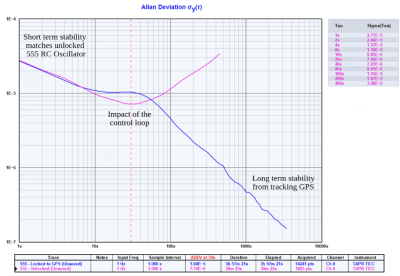One of the categories we chose for the One Hertz Challenge is “Could Have Used a 555.” What about when you couldn’t have, but did anyway? The 555 is famously easy to use, but not exactly the most accurate timer out there — one “ticking” at 1 Hz will pulse just about once per second (probably to within a millisecond, depending on the rest of the circuit), but when you need more precise timing, the 555 just won’t cut it. Not on its own, anyway.

This entry by [burble] shows us how the humble 555 can hold its own in more demanding systems with some help from a GPS receiver. He used the One Pulse per Second (1PPS) output from a GPS module to discipline the 1 Hz output from a 555 by modulating the control voltage with a microcontroller.
Okay, this sounds a bit like baking a cake by buying a cake, scraping all the icing off, then icing it yourself, but what better way to learn how to ice a cake? The GPS-disciplined 555 is way more accurate than a free running one — just check out that Allan Deviation plot. While the accuracy of the standard 555 begins to decrease as oscillator drift dominates, the GPS-disciplined version just keeps getting better (up to a point — it would also eventually begin to increase, if the data were recorded for long enough). Compared to other high-end oscillators though, [burble] describes the project’s accuracy in one word: “Badly.”
That’s okay though — it really is a fantastic investigation into how GPS-disciplined oscillators work, and does a fantastic job illustrating the accuracy of different types of clocks, and some possible sources of error. This project is a great addition to some of the other precision timekeeping projects we’ve seen here at Hackaday, and a very fitting entry to the competition. Think you can do better? Or much, much worse? You’ve got a few weeks left to enter!













